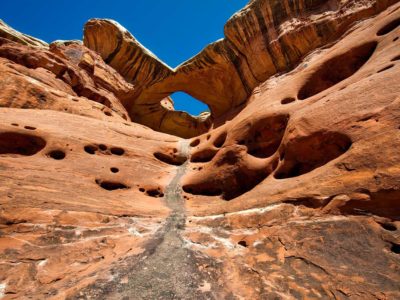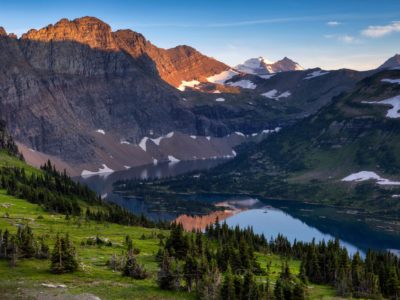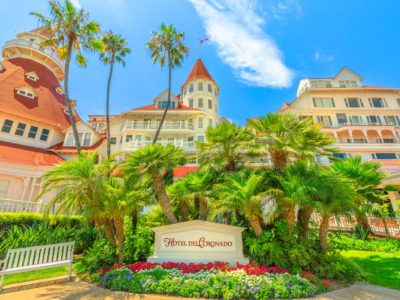The national parks in Utah have long been the perfect playground for backpackers. Connecting all five is a rite of passage for travelers not just in the United States, but around the world.
Each of the five Utah national parks has something unique to offer. From sweeping canyons, hoodoos, and natural amphitheaters to rugged orange cliffs that showcase the best of the Wild West.
Whether you’re looking to explore them all or just one, our guide will take you through what makes each of Utah’s national parks so spectacular, what trails to hike, and where to stay.
Table of Contents
Travel Guide to Utah National Parks Mighty 5
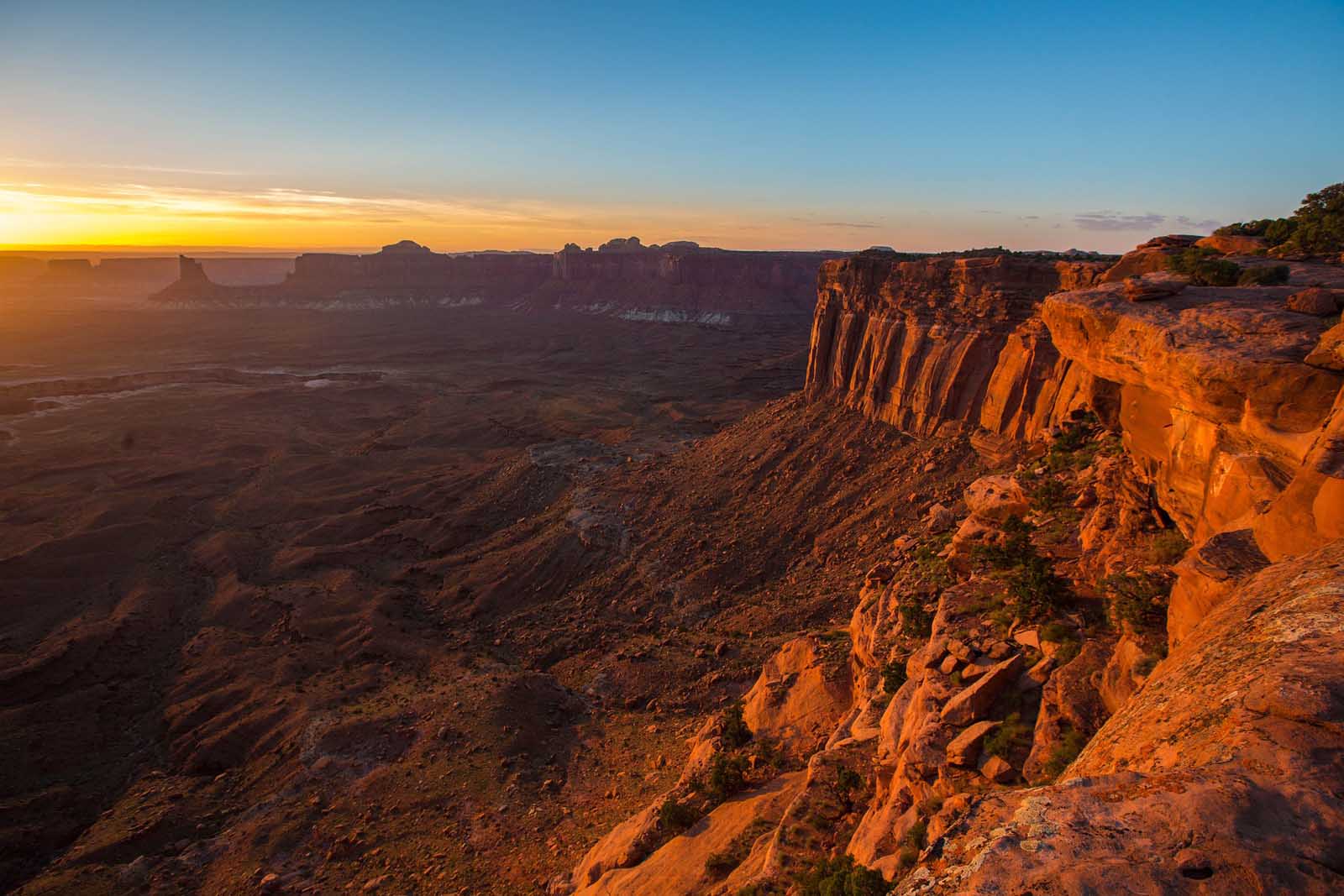
When it comes to natural beauty I think that Utah is probably one of the most beautiful states in the US. With varying landscapes like mountains and deserts, it is easy to see why. After a visit to Salt Lake City in the north make sure to head down to southern Utah where there are 5 national parks in a relatively small area. Zion National Park, Arches National Park, Canyonlands National Park, Bryce Canyon National Park, and Capitol Reef National Park are all located here.
We took a road trip through this area of the US and visited these parks before heading into Arizona to visit the Grand Canyon. I think this is a trip everyone should put on their bucket list. Below, we have put together a Travel Guide to these 5 Utah National Parks that will help you get the most out of each one.
1. Zion National Park
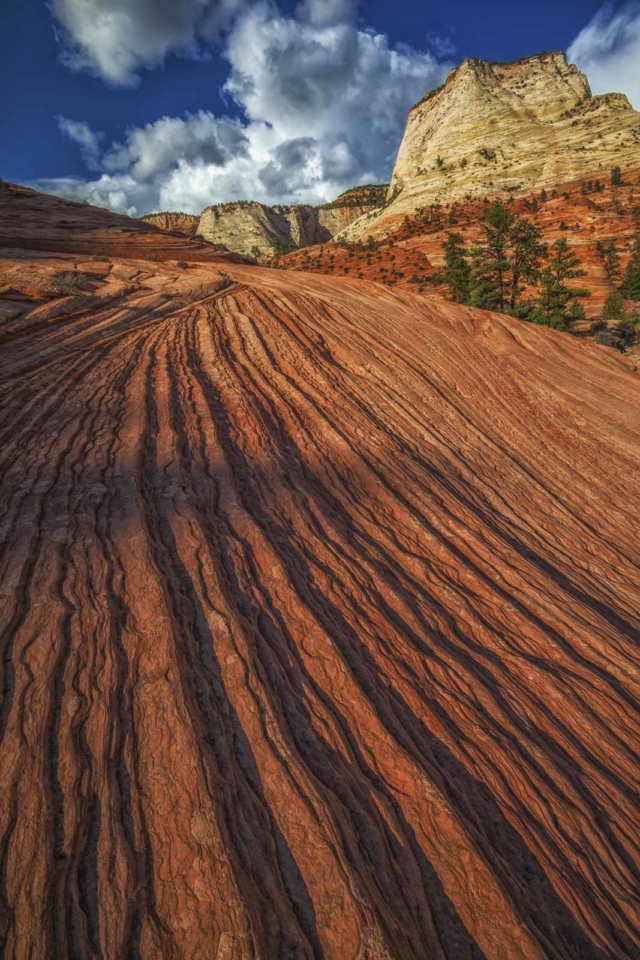
As Utah’s oldest national park, Zion has lost none of its grandiosity since its opening in 1919. It’s a place of wonderment, the crown jewel of Utah’s epic national park system. Located in Southern Utah, its esteem has been well earned because of its array of vast and narrow canyons, rainbow rock formations, natural monuments, and stunning vistas.
Upon discovery in 1863, Zion was labeled the Promised Land. It still rings true today, a place that promises (and delivers) spectacular hikes, some of the best canyoneering anywhere on earth punctuated by desert waterfalls that add extra life to the colorful, but arid landscape.
If you have a car, don’t pass up on the Zion Canyon Scenic Drive. In a state made for road trips, the short and sweet journey is the icing on the cake.
Zion National Park Hiking Trails
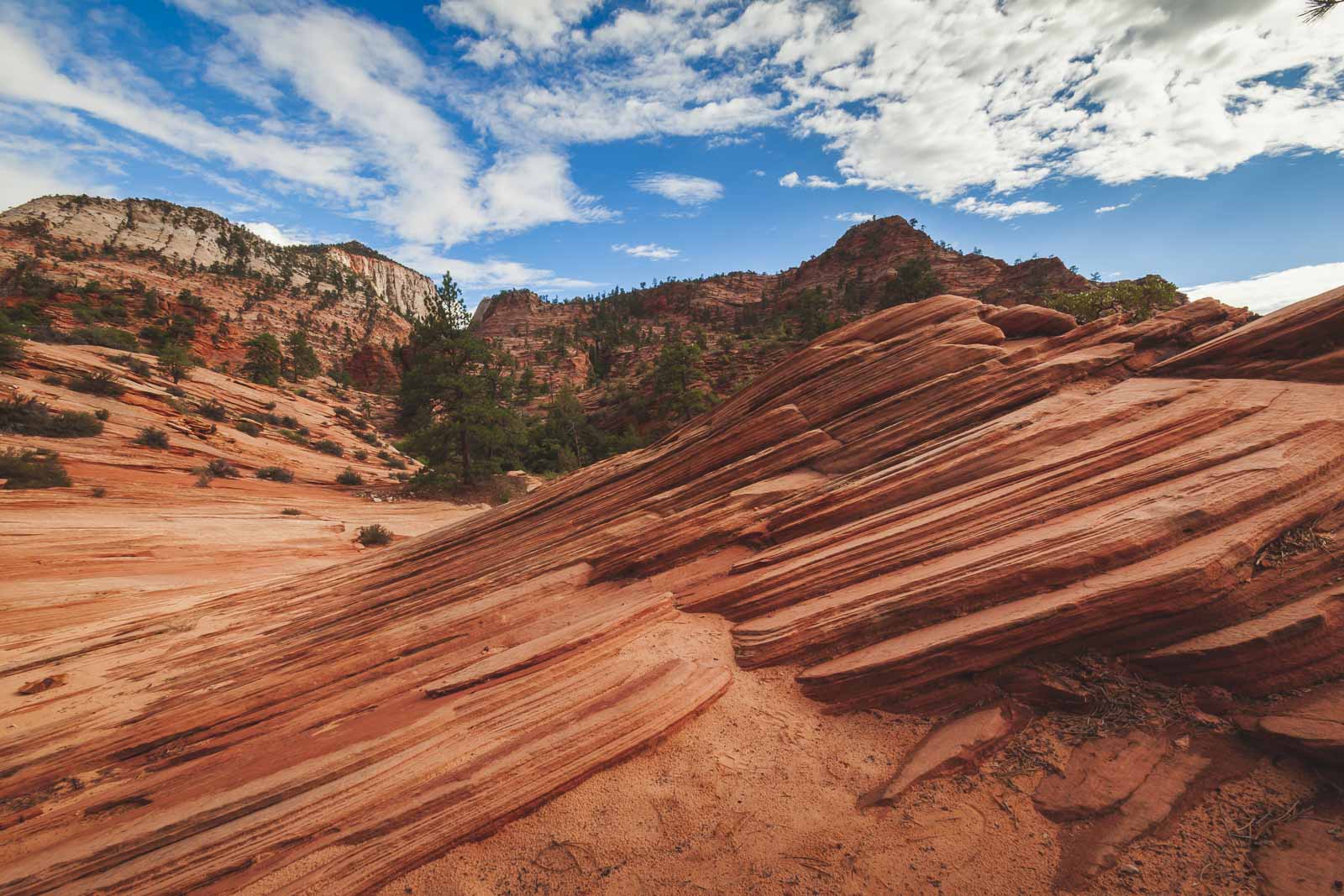
1. The East Rim Trail
For an epic full-day trek, don’t look past Zion’s East Rim Trail. The lengthy 22 miles will have you working up a sweat as you venture deep into the park exploring every inch of the eastern canyon. The hike is rated as moderate to difficult.
You can start in two different spots, with the East Entrance being the most common. From there, trek up and down into the spectacular Echo Canyon. In the other direction, you’ll hit the fascinating Weeping Rock first.
To get here, jump off at Shuttle Stop 7 readying your legs for 2400 feet of ascent up the side of Echo Canyon.
2. The Narrows
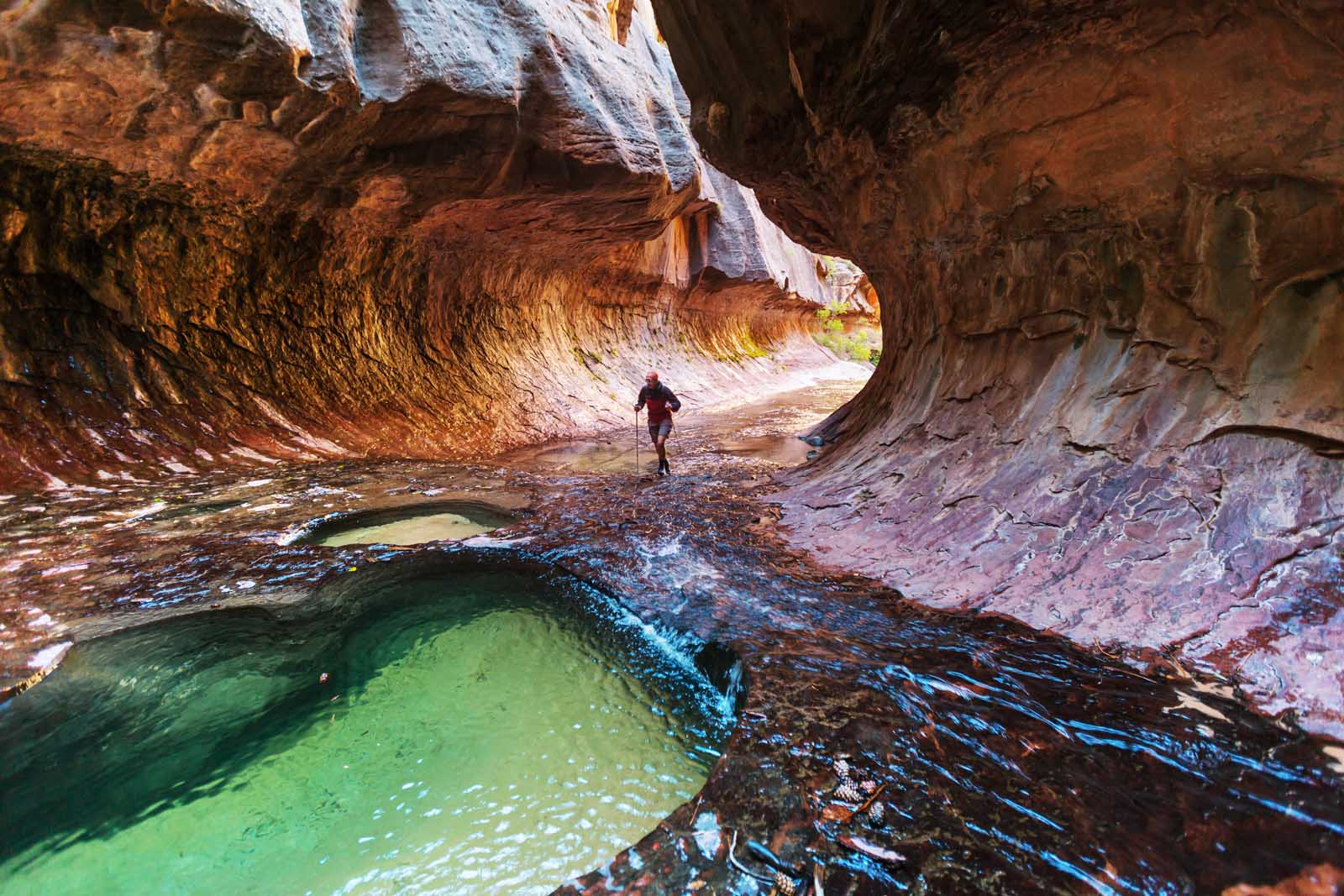
Zion National Park was carved by the Virgin River. The Narrows Trail takes you along the water, deep into the intricate slot canyon. As you wander beside and sometimes through the river, the walls of the canyon rise to either side, curling and rising above your head.
The vibrant colors of the rock cover all shades of browns, reds, oranges, and yellows, with some black scars added for good measure. The trek is a sensory experience, with each splash of water echoing along the trail.
You can hike the moderate to difficult trail in either direction, with a popular choice being the 16 miles down to Chamberlain Ranch to camp overnight. Before arriving at Zion, you’ll need to grab a permit for this hike.
3. Emerald Pools Trail
The Angels Landing hike may be one of the most popular in the United States. But it’s been written and walked to oblivion. The Emerald Pools trail is an underrated, easy to moderate hike that’s as fun for adventurers as it is for families.
The trail’s name promises a certain type of natural grandeur and it certainly delivers. Along the short 3 mile trek, you’ll enjoy a trio of emerald pools sparking under the Utah sun. You’ll reach the first pool in a single mile, one that also features a breathtaking waterfall. A brief stroll will take you to the Middle Emerald Pools Falls, one that will have you sitting and admiring the views for a while yet.
Those feeling adventurous can add in some light scrambling to reach the Upper Emerald Pools. To reach the trailhead, make your way to Shuttle Stop 5.
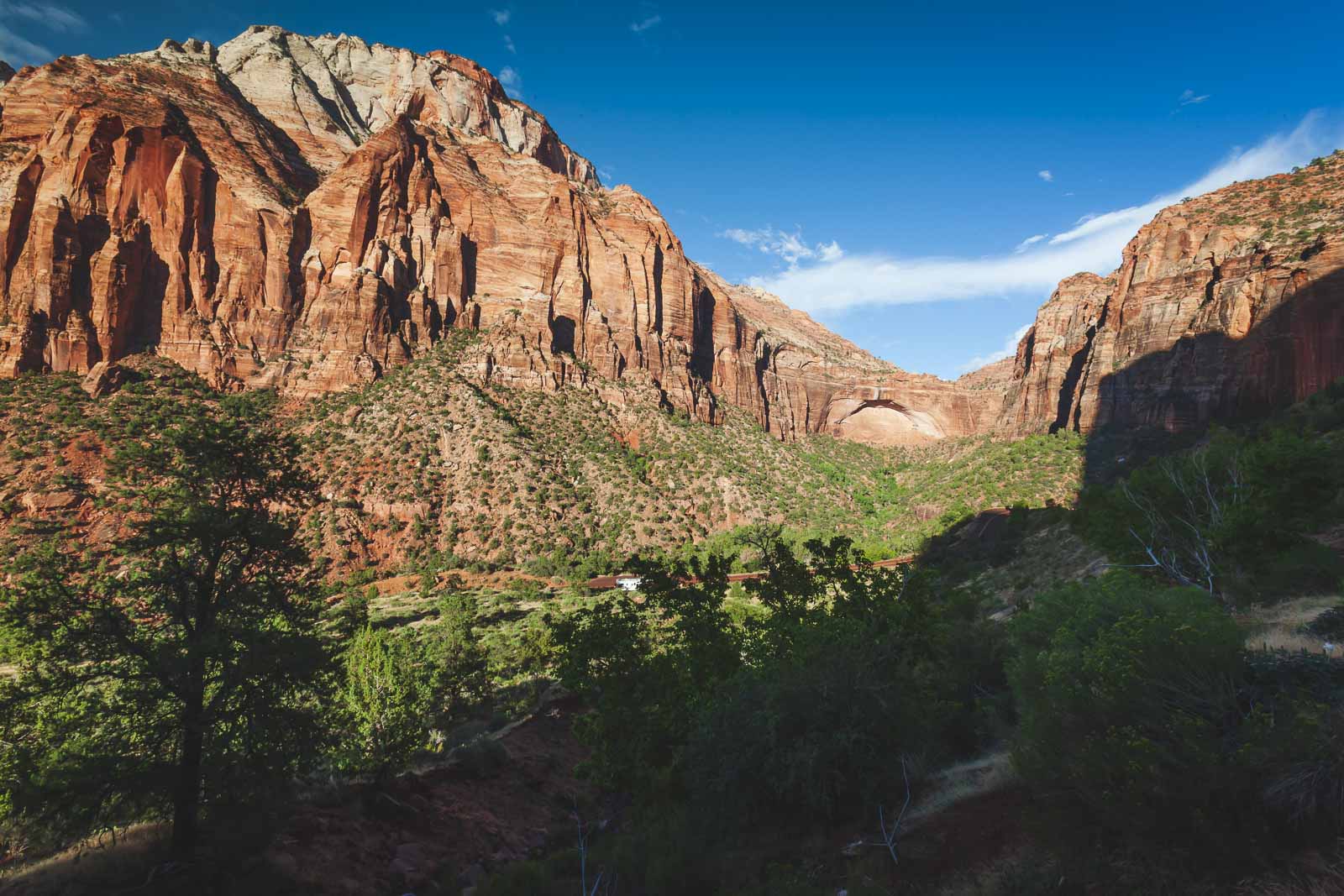
Don’t miss our in-depth guide to the Best Hikes in Zion National Park!
How to get there
The national park is located in Springdale, in southern Utah. The nearest major airport is McCarran International Airport in Las Vegas.
- From Las Vegas: 2h and 40m (160 miles)
- From Salt Lake City: 4h 30m (308 miles)
Entrance Fee
- Private Vehicle: $35 (<15 passengers)
- Motorcycle: $30
- Walk/Ride: $20
- Zion Annual Pass: $70
Where to stay near Zion National Park
Open Sky: A desert night sky is always a front-row seat to a spectacular star experience. With Open Sky, you’ll have ceiling windows to see the Big Dipper from the bed. When the sun rises, the colorful sky will be a soothing alarm clock. Grab a cup of coffee, and sit out on your private deck before venturing into the park.
Zion Wildflower Resort: Forget the stuffy hotel room, wake up in the best of local nature at Zion Wildflower Resort. The glamping resort has a private balcony looking out over the tablelands. Make use of bike rentals, local hiking trails, and a bathhouse before taking in the night sky under your heated blanket.
Arches National Park
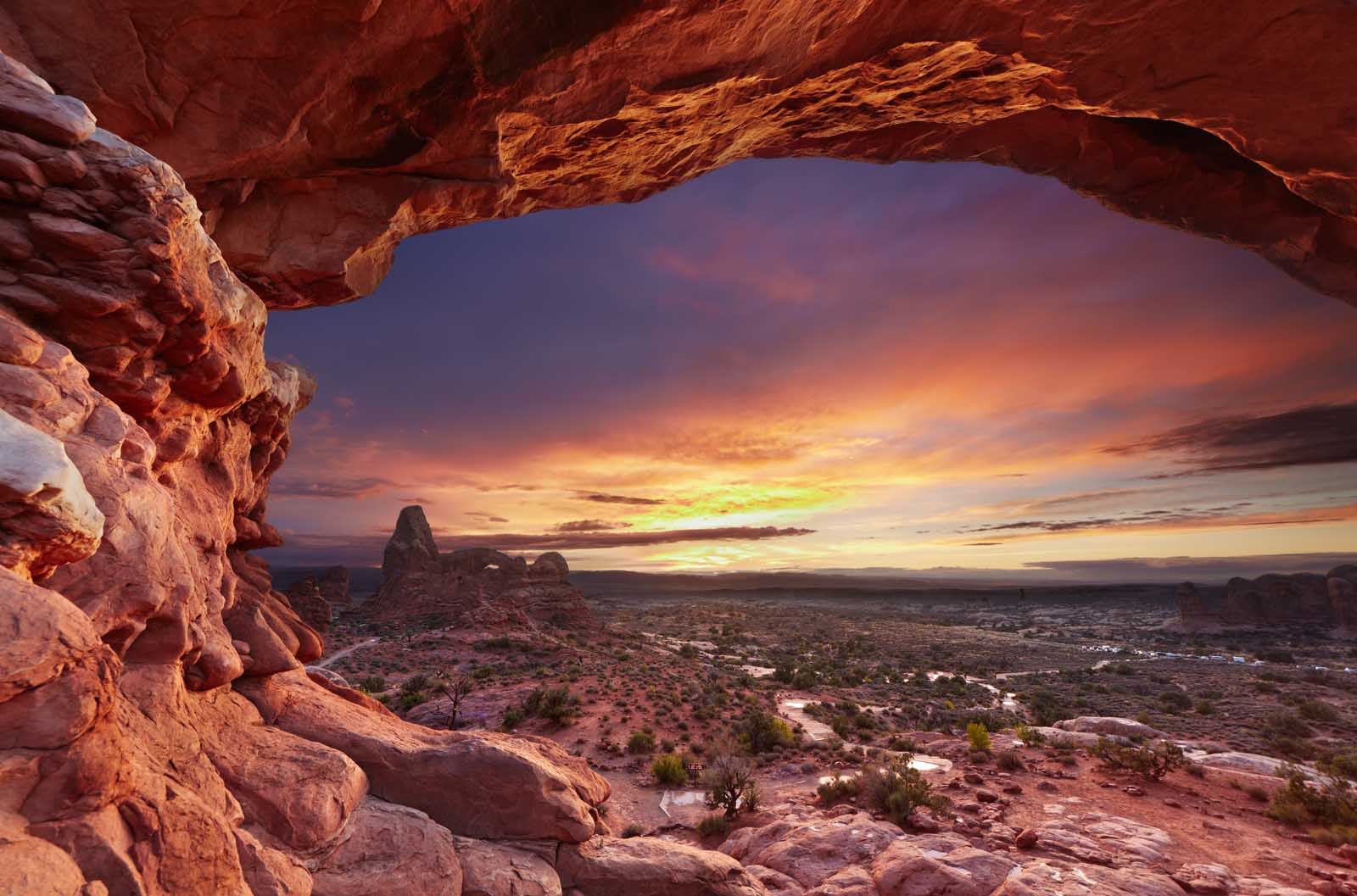
Arches is classic Utah, where jaw-dropping scenery comes standard. But what elevates Arches National Park to one of the best in the United States is its spellbinding collection of natural monuments. No place on earth has as many sandstone arches. In fact, you’ll find over 2,000 if you’re willing to put the steps in.
The park’s name gives away the surprise. But to the glee of all travelers, the arches aren’t the only incredible geological wonders here. On the many hikes and along the scenic road, spot enormous boulders balancing on another and admire soaring fins and rock spires that stand like iconic statues and Romanesque churches.
The nature of Arches National Park means there is an abundance of short, family-friendly trails. But those chasing seclusion will be rewarded with a resplendent backcountry. The park also forms a part of the Spanish National Historic Trail.
Arches National Park Hiking Trails
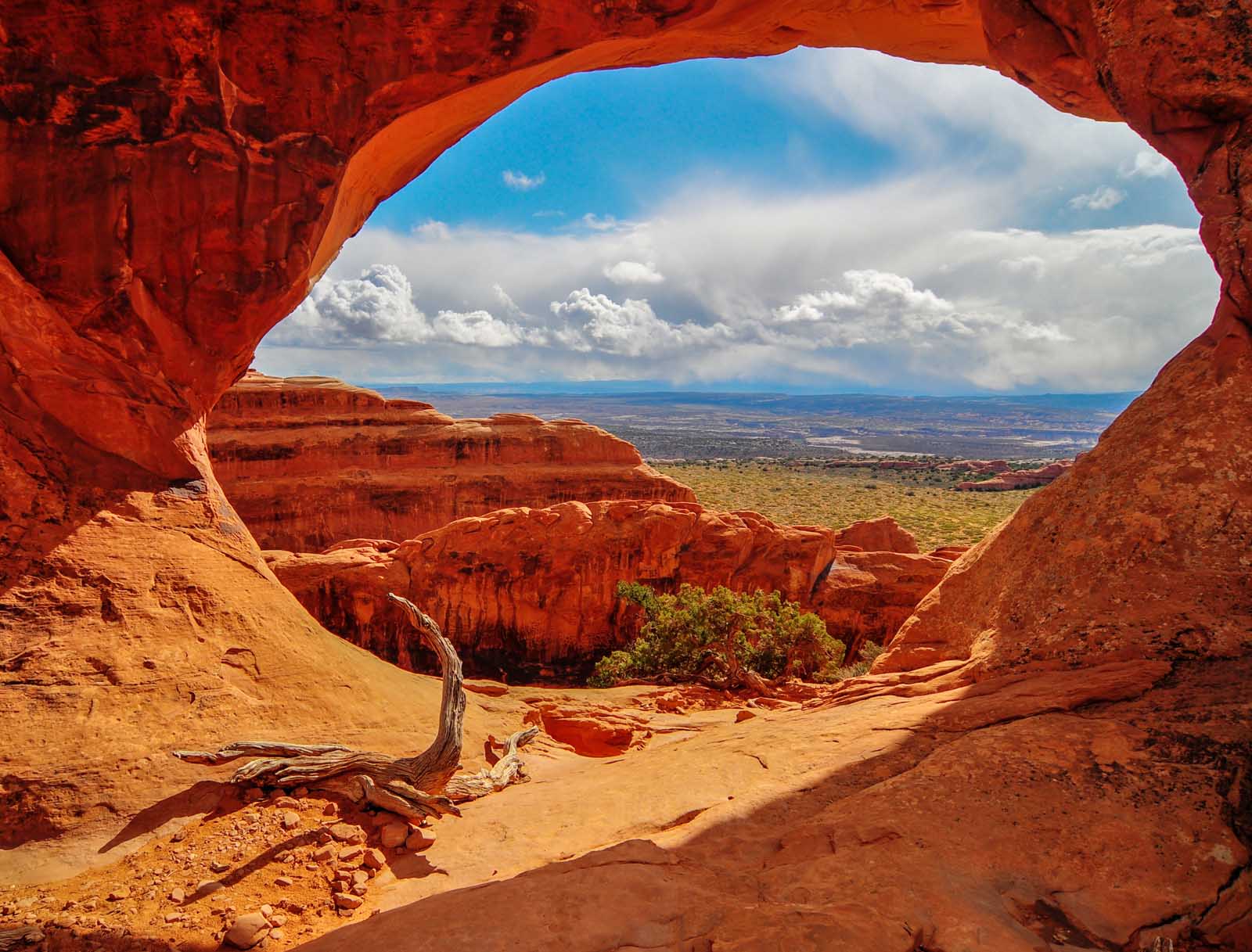
1. The Primitive Loop
Found within the park’s Devil’s Garden, Primitive Loop is a fantastic longer hike. The eight-mile trail will help stretch your legs while showcasing a brilliant section of Arches National Park.
The entire garden is a labyrinth of trails that burst off into a variety of directions. But the main trail takes you along thin ledges and some tricky but thrilling rock scrambling with rock cairns guiding the way. Some of the many arches you’ll see along the hike include the gorgeous Double O Arch and Private Arch. Double O is the second biggest in Devil’s Garden, with one being 71 feet wide and the other 21.
2. Delicate Arch
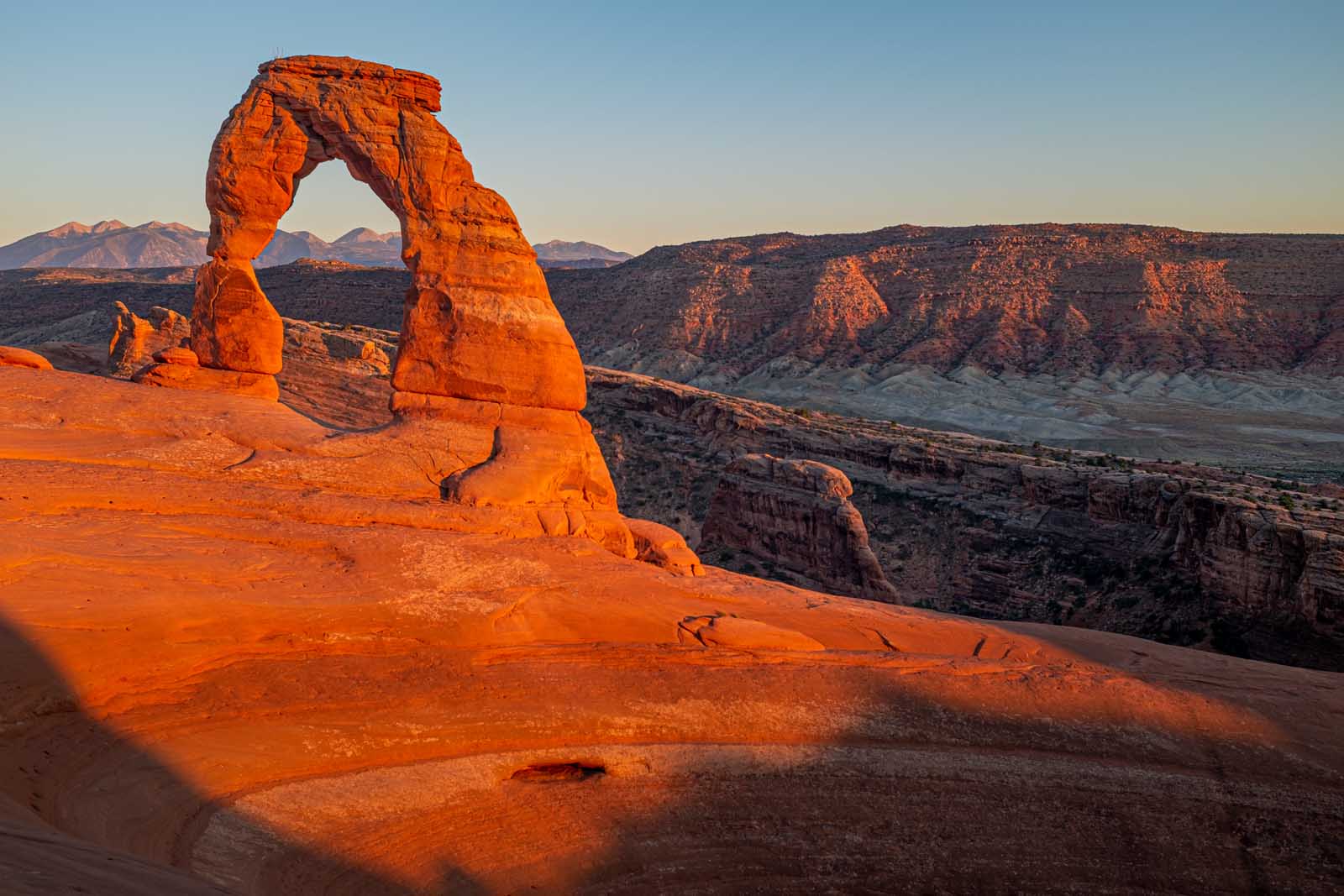
Starting at Wolfe Ranch Parking Lot, this 3-mile moderate trail takes you to the most beloved parts of Arches National Park. In a park full of natural arches, this one stands alone, free-standing, and utterly breathtaking.
Owing to its length and popularity, the trail can get crowded. It’s one worth getting up at the crack of dawn for sunrise or waiting patiently for sunset. This will help you avoid the crowds while also seeing the arch at the best times of the day. As anyone who’s been around a desert sky would know, the clear horizon, open sky, and arid colors combine to create a kaleidoscopic world of lights and shadows that will fuel you for the rest of your trip.
3. Park Avenue Trail
The natural arches may bring in travelers from around the world, but the park’s wide range of intricate rock formations will linger long in your memory. An easy way to see some of the strangest and sometimes confusing formations, hike the Park Avenue Trail.
The 4 mile out and back hike is easy and comes with minimal elevation gain. Start with the brief trek to Park Avenue, with the beguiling rocks reminding hikers of a city’s downtown. Then walk down into the vast canyon, passing endless rows of mesmerizing conglomerates on your way to the memorable Courthouse Towers.
Along the way, enjoy long-range views of the La Sal Mountains as you walk by iconic formations such as the Organ, Sheep Rock, and Three Gossips.
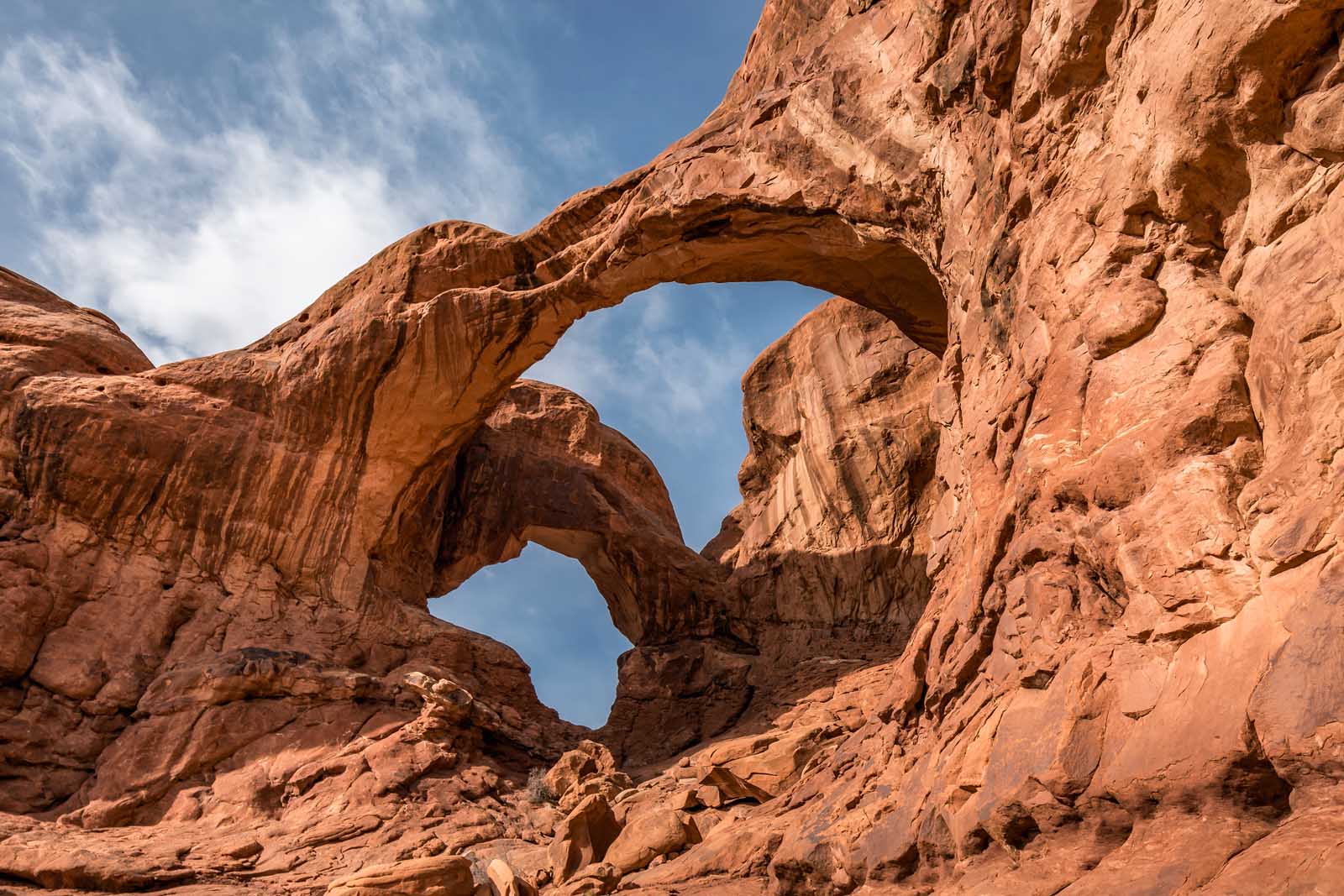
Don’t miss our in-depth guide to the Best Hikes in Arches National Park!
How to get there:
Arches National Park is just outside of Moab, in eastern Utah. The closest major airport is Grand Junction Regional Airport, Colorado.
- From Moab: 8 minutes (5 miles)
- From Grand Junction: 1hr 40m (109 miles)
- From Salt Lake City: 3hr 40m (230 miles)
Entrance Fee:
- Private Vehicle: $30 (<15 passengers)
- Motorcycle: $25
- Walk/Ride: $15
- Southeast Utah Parks Pass: $55
Where to stay near Arches National Park:
Sorrel River Ranch: Surrounded by towering red rock mesas, canyons, and arches on the banks of the Colorado River, the Sorrel River Ranch combines natural opulence and the Wild West. Indulge in luxury on this 240-acre oasis with tours, rafting, mountain biking, and soothing spa treatments available.
Under Canvas: Have all the hotel amenities without compromising on nature and views at Under Canvas. Take in the crystal clear night skies as you enjoy a luxury camping experience. Wake up to the sun rising over the mesas with the views streaming through your floor to tent ceiling windows.
Bryce Canyon National Park
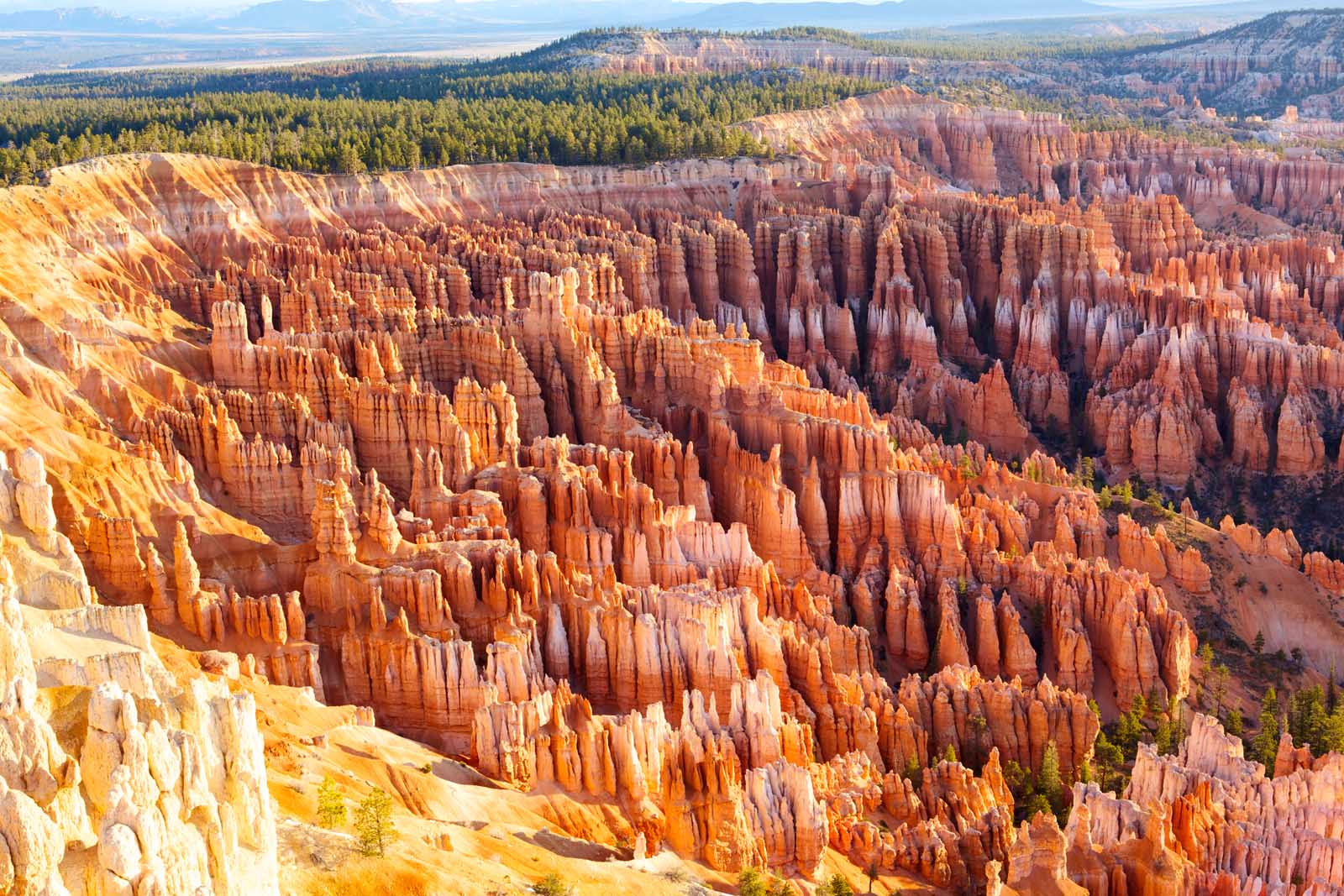
Rising like a church choir out of the red-orange dirt in southwestern Utah, the hoodoos of Bryce Canyon National Park have created a natural wonderland.
Delicately shaped by millions of years of wind, rain, and snow, Bryce Canyon is a paradise for hikers and photographers alike. The park has natural bridges and is teeming with rock spires that form spectacular amphitheaters. It’s like the park is an orchestra and we are the lucky audience.
Throughout, you’ll find hiking trails that take you from the lowly Paria Valley to above 9,000 feet in the forests along the Paunsaugunt Plateau. In between are exceptional experiences, epic views, and some of the best rock climbing in the state.
Bryce Canyon National Park Hiking Trails
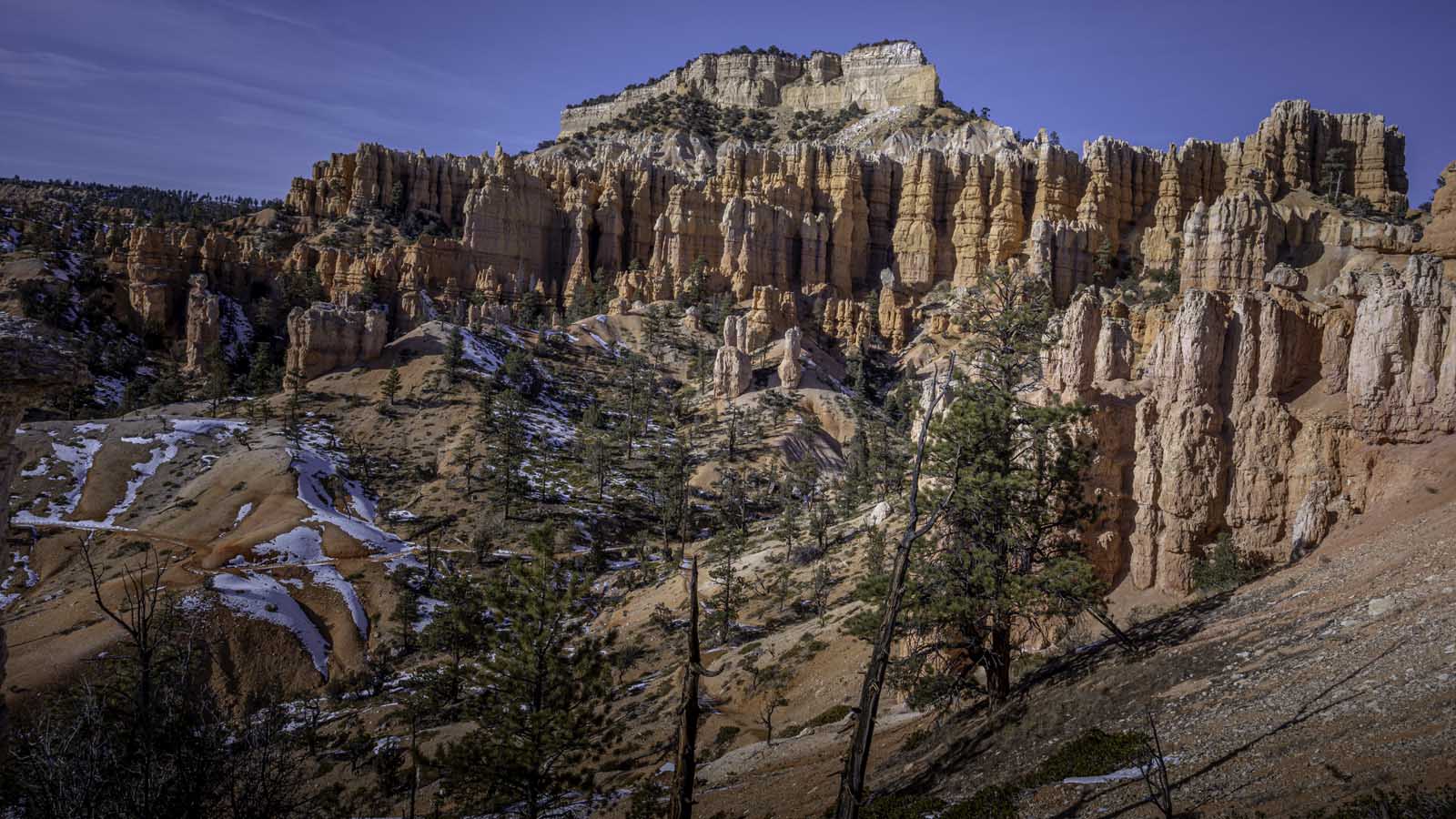
1. The Rim Trail
To see a lot of the park on a single trek, put on your hiking boots and explore the Rim Trail. 11 miles return, the moderate trail comes with a steep incline to begin. But once you’re at elevation, you’ll have splendid, heart-stopping views in every direction.
Start at Bryce Canyon Point, which you can reach on the park’s shuttle. The highlight of the experience is capturing the Bryce Amphitheater in all its glory. Hike into the amphitheater on one of three hikes or continue on to admire more of the trail’s prismatic topography.
2. Bryce Point to Sunrise Point
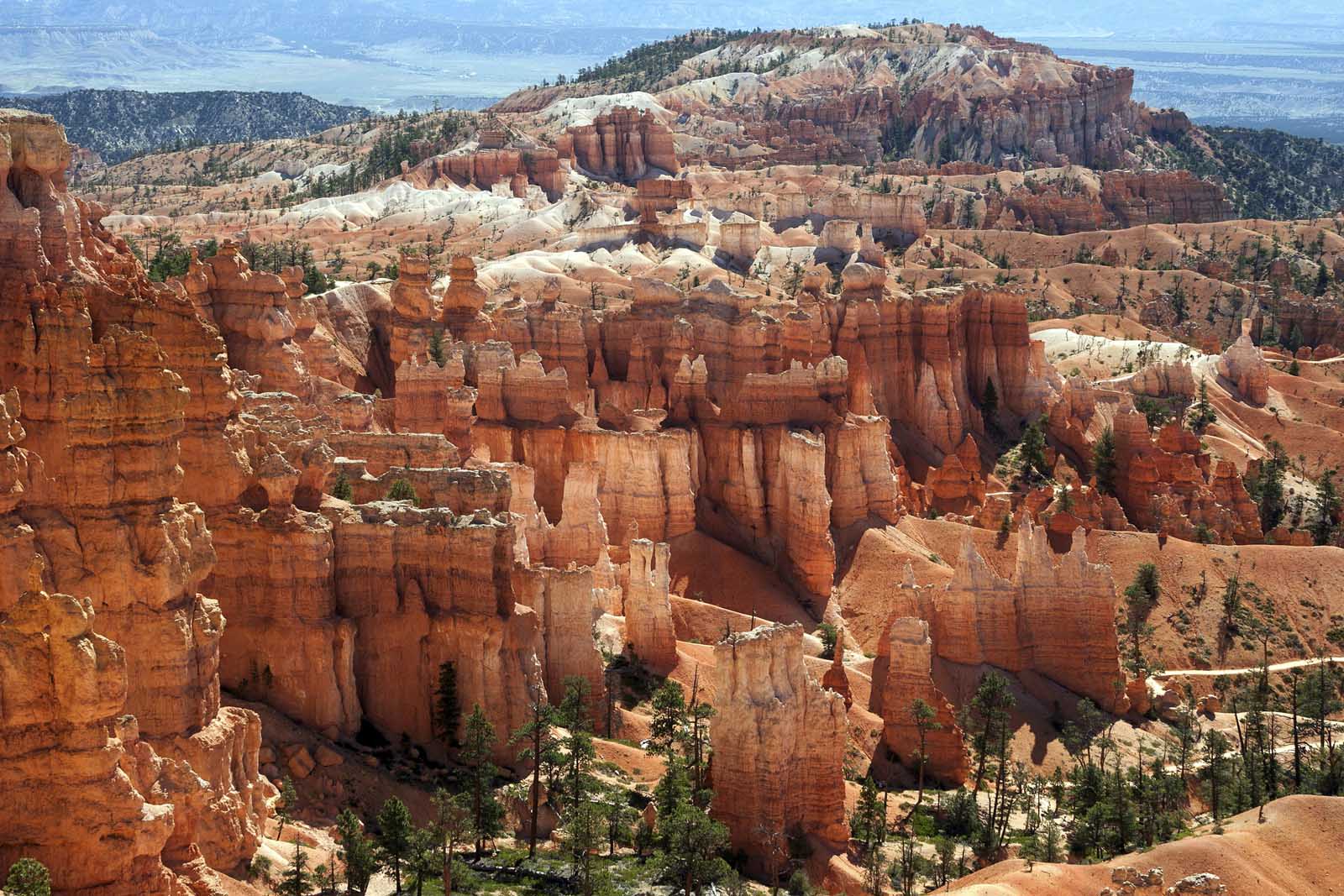
This 8-mile moderate hiking trail provides many of the park’s intriguing geological wonders in one place. The trail begins with a beautiful trek to Sunset Point. After your walk at elevation, descend into the famous amphitheater via the Navajo Loop Trail. Venture down into the aptly named Wall Street with sandstone spires soaring left and right.
The magical vistas continue to get better as you trek beside the hoodoos along the brilliant Queen’s Garden Trail. Here, the rock monuments soar through the pines before being replaced by the Two Bridges Hoodoo. Eventually, you’ll reach Sunrise Point for an awe-inspiring view.
3. Fairyland Loop Trail
Beginning at Fairyland Point, a stop along the shuttle route, the Fairyland Loop Trail is one of the best day hikes in Bryce Canyon National Park. Covering 8 moderate miles, the trail will take you all the way to Sunset Point for an enthralling golden hour.
The trail takes you by many spectacular hoodoos, but the real highlight is Tower Bridge. Named after the famous bridge in London, the natural phenomenon stands imposingly above the rest of this unforgettable landscape. For many, this is a common turnaround point.
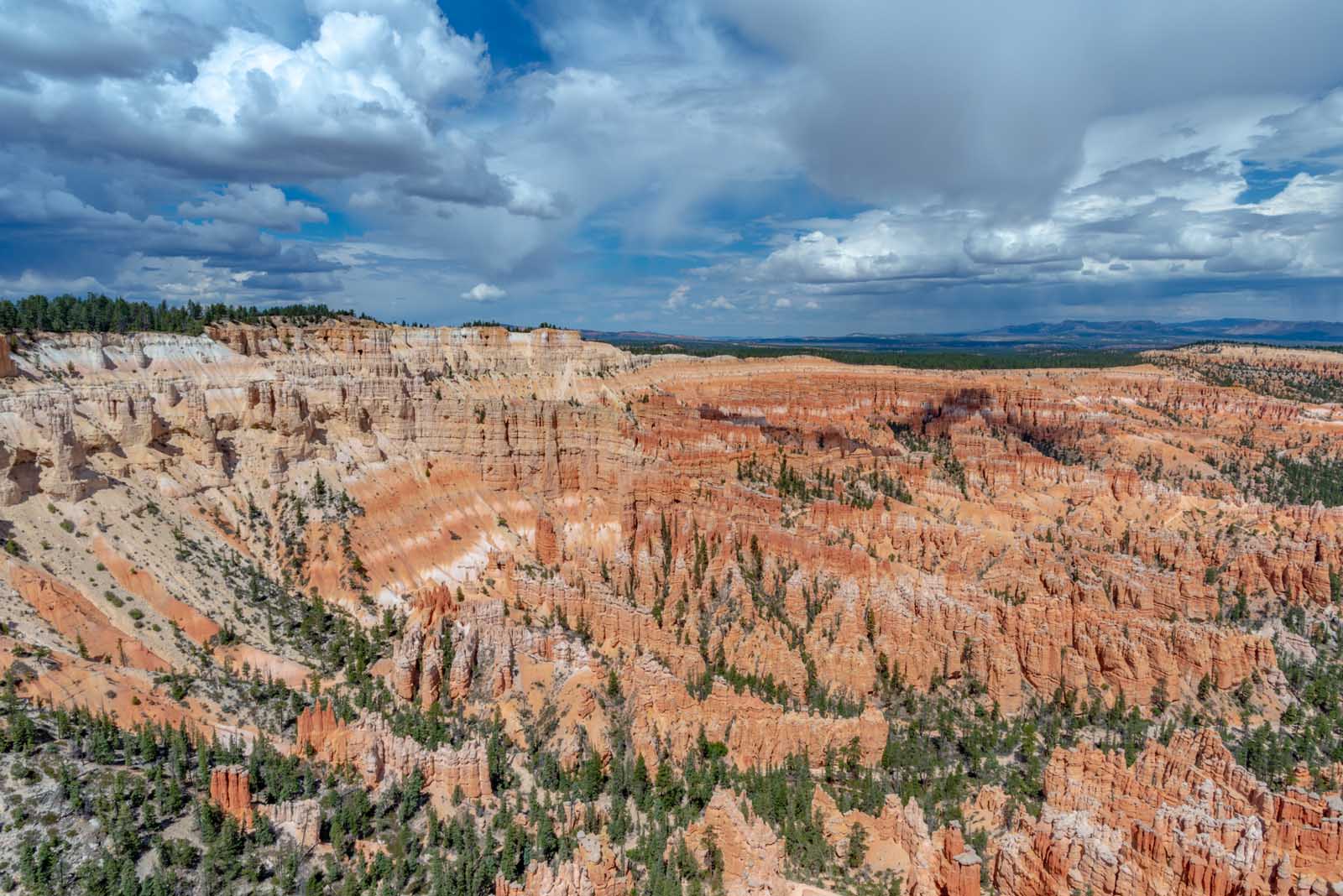
Check out our in-depth guide to the Best Hikes in Bryce Canyon National Park!
How to get there:
Bryce Canyon is south of Bryce, in Southern Utah. The closest major airport is McCarran International Airport in Las Vegas.
- Las Vegas: 4hr (260 miles)
- Salt Lake City: 4hr (268 miles)
- Zion National Park: 1hr 20m (72 miles)
Entrance Fee:
- Private Vehicle: $35 (<15 passengers)
- Motorcycle: $30
- Walk/Ride: $20
- Bryce Canyon Annual Pass: $70
Where to stay:
The Lodge at Bryce Canyon: Offering unparalleled access to the park’s best sites, the Lodge at Bryce Canyon is all about location. The accommodation has few modern amenities, instead of allowing nature to be the star of the show. From the door, you’ll have a short walk to some of the best trails.
Bryce Canyon Log Cabins: 15 minutes from the park, the log cabins are charming and cozy. Enjoy a rustic experience with all the modern comforts. You’ll also have stunning vistas, including a front-row seat for both sunrise and sunset.
Capitol Reef National Park
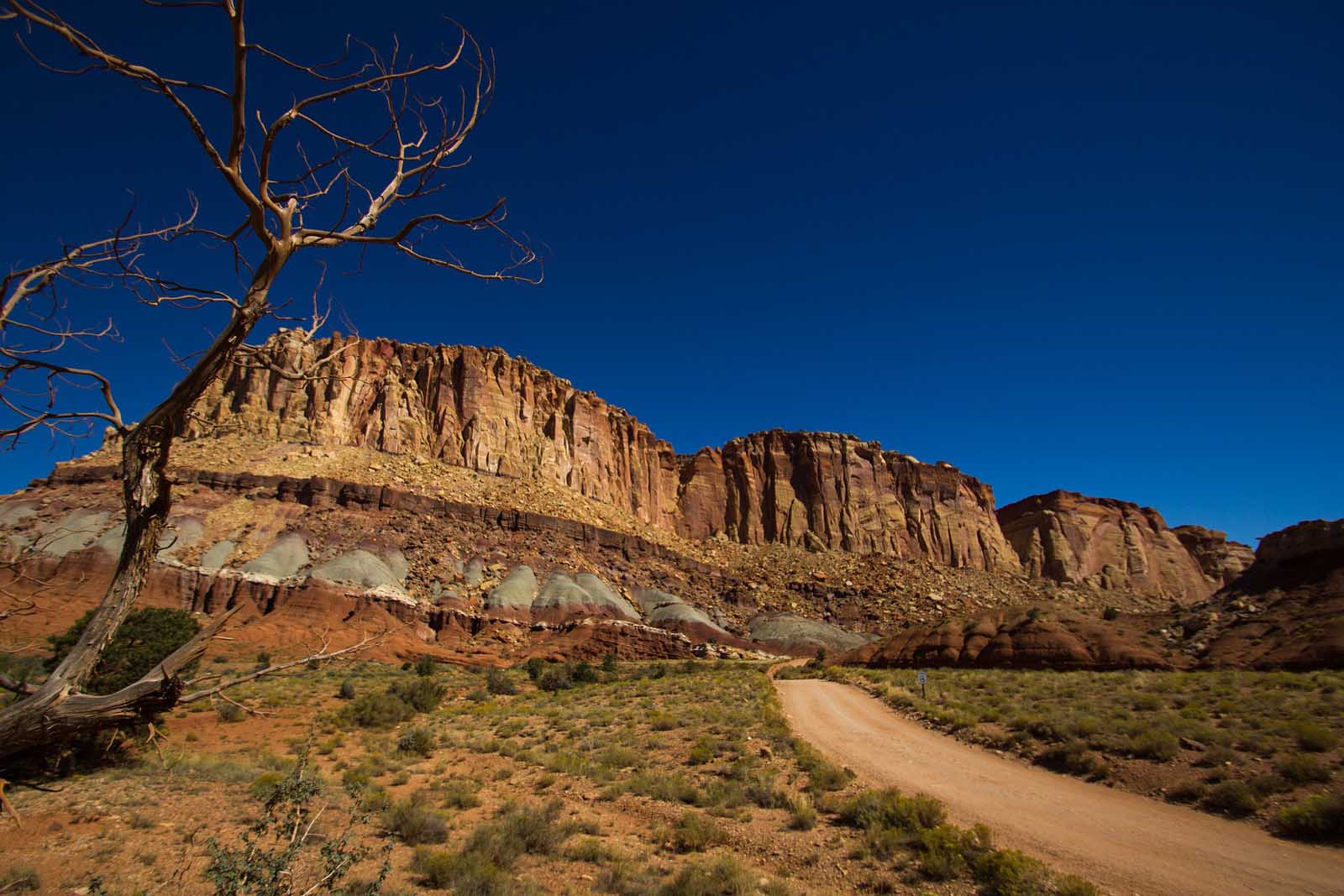
In south-central Utah, Capitol Reef National park exists in the shadows of other renowned Bryce Canyon and Zion. But if we’ve learned anything from the national parks in Utah, is that they’re all impressive in their own ways.
Capitol Reef is in the heart of red rock country, a treasure trove of domes, canyons, and cliffs. It’s a park that gets better the more you explore, with a plethora of hiking trails, 4WD trails, scenic roads, and the fascinating Fruita district.
Without the popularity of other Utah national parks, you’ll contend with less traffic on the equally beautiful paths that take you to cathedral monoliths and endless desert views.
Capitol Reef National Park Hiking Trails
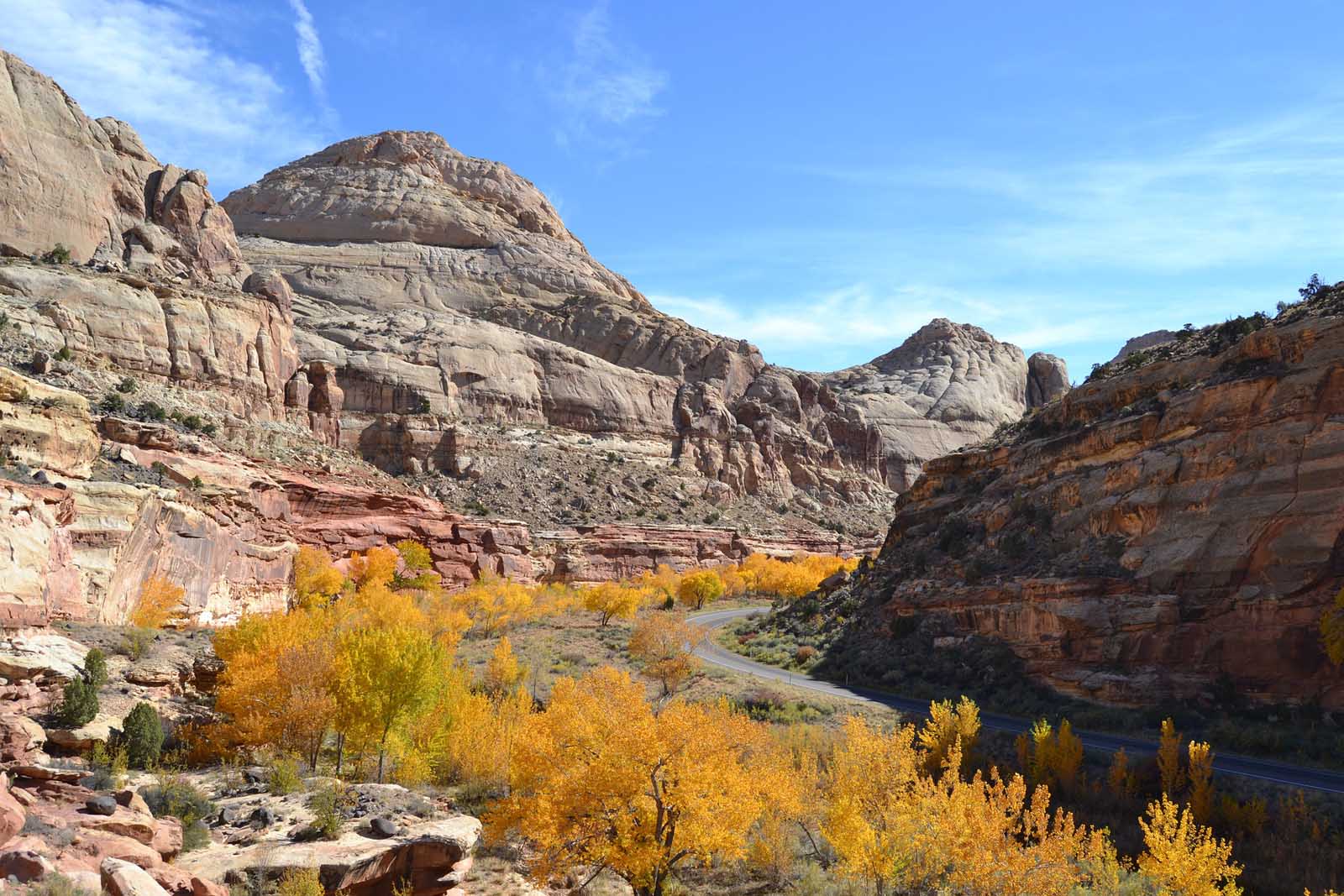
1. Cohab Canyon Trail
The gilded Cohab Canyon features honeycomb walls mixed with reds, oranges, and oxidized iron. It’s arguably the most multi-faceted canyon in Capitol Reef National Park. Its captivating beauty was once home to the many wives of the polygamists in Fruita.
As you walk along the 3.4-mile return trail, the canyon makes way for mini archways and dramatic hoodoos that exist within the Kayenta Formation. To lengthen the hike, join a duo of trails that lead to views above the Fremont River and Fruita.
2. Cassidy Arch Trail
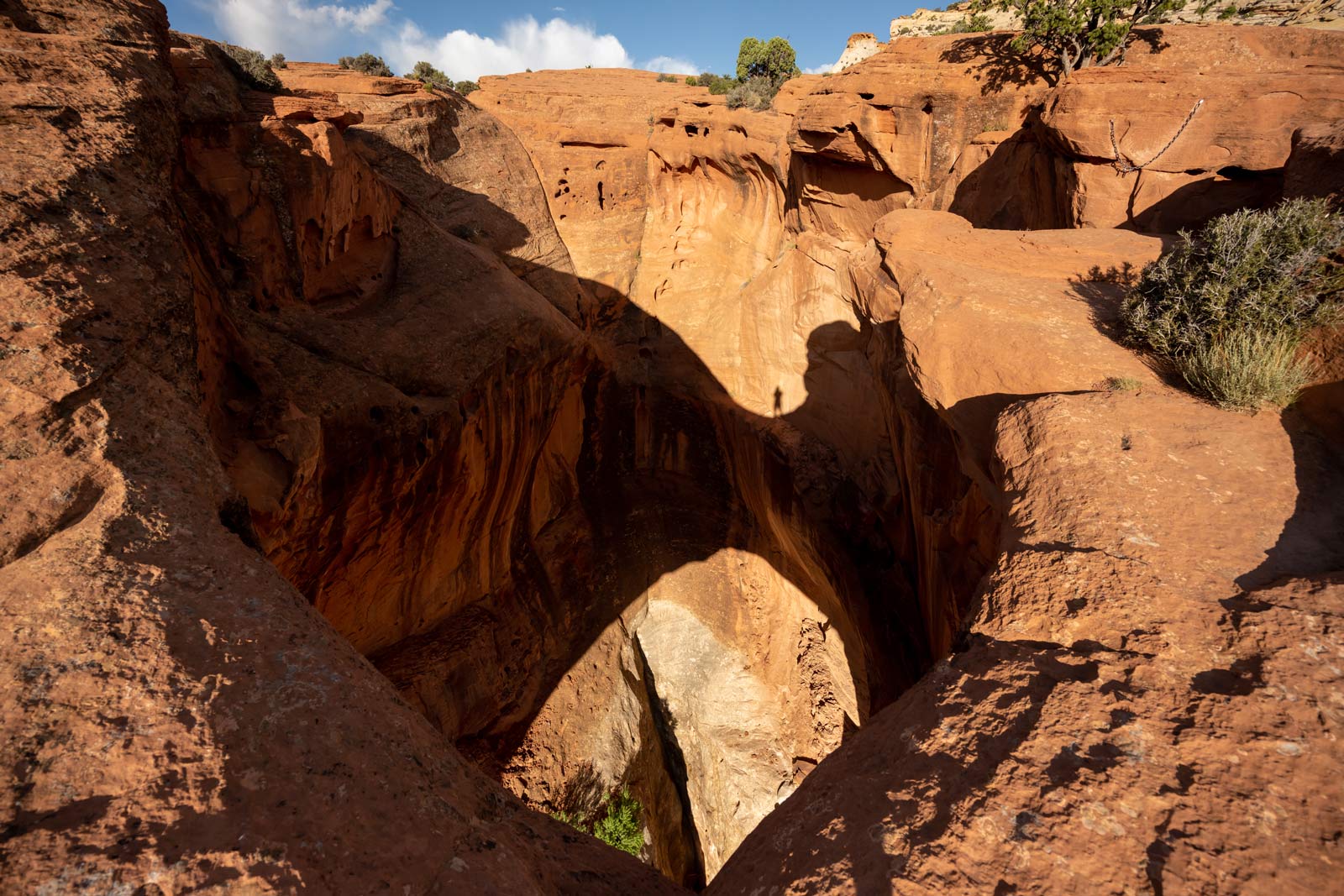
You don’t have to go to Arches to admire nature’s incredible engineering. The moderate trail is 3.4 miles long and takes you to the famous Cassidy Arch.
The hike is beautiful throughout, guiding you along the edge of a canyon with plenty of epic views. Just be warned, you’ll often walk alongside a large drop-off.
The arch isn’t just a beautiful sight, it’s one of the few you can walk across. The memorable experience is sure to get the heart racing but will make for some amazing photos.
3. Upper Muley Twist Canyon
Those seeking a true adventure should consider the Upper Muley Twist Canyon. The 14.8-mile, difficult trail takes you by arches, through narrow slot canyons, and along an elevated rim.
The trail follows the canyon as it carves its way through the Waterpocket Fold, showcasing Wingate and Navajo sandstone along the winding canyon. The rock has eroded, creating a swath of interesting formation, from arches to honeycombs.
The trail meanders through narrow canyons and by slip rock to dramatic views. The trail is marked by cairns, but a map is recommended.
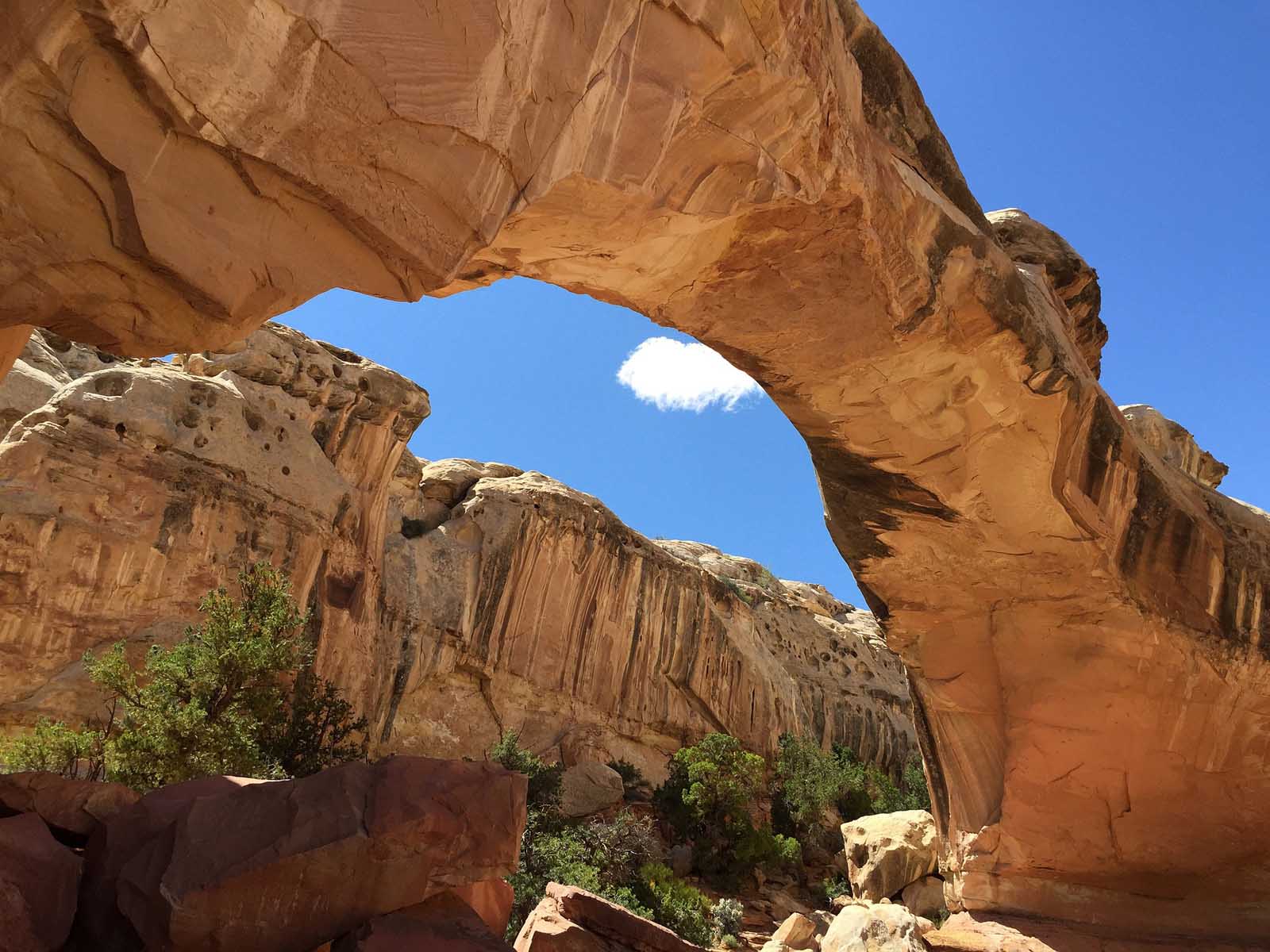
How to get there:
Capitol Reef is just outside of Torrey in Southern Utah. The nearest major airports are in Grand Junction and Salt Lake City.
- Grand Junction: 2hr 50m (186 miles)
- Salt Lake City: 3hr 25 min (218 miles)
- Las Vegas: 5hr 10m (327 miles)
Entrance Fee:
- Private Vehicle: $20 (<15 passengers)
- Motorcycle: $15
- Walk/Ride: $10
Where to stay:
Fruita Campground: Enjoy a budget-friendly, picture-perfect stay on the edge of the park at Fruita Campground. The site has bathrooms, water, and free fruit on the orchards. Have views of the eye-catching rock faces with the subtle sounds of nearby wildlife.
Capitol Reef Resort: To have simple and luxury lodgings, stay in comfort at Capitol Reef Resort. Recharge the batteries each night with beautiful views from your room that frames the nearby park.
Canyonlands National Park
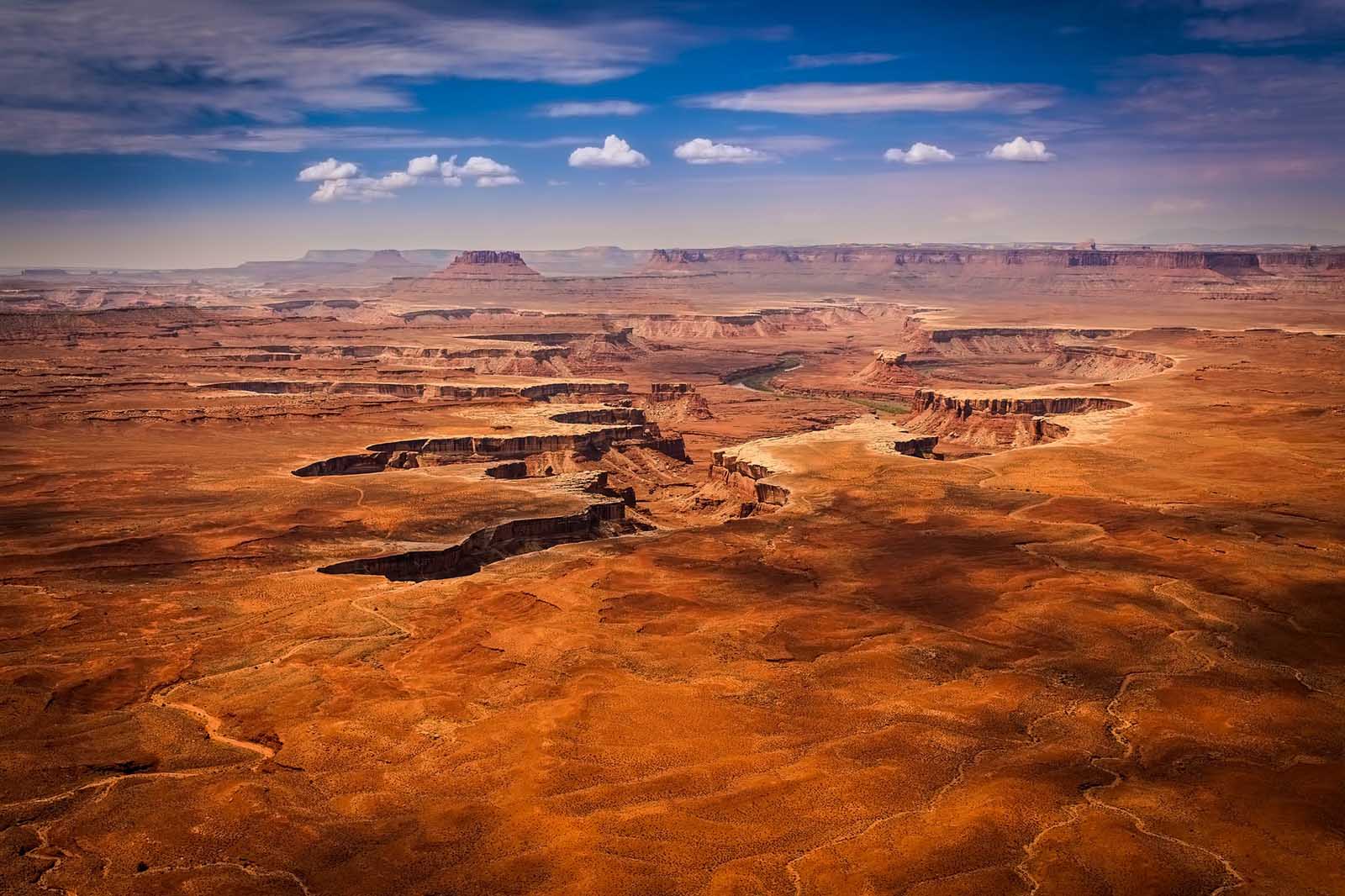
Utah’s largest national park, Canyonlands harbors some of the rawest and most inspiring landscapes in the American West. The park has been carved by the imposing Green River and Colorado River which converge in the heart of Canyonlands.
Of all the amazing Utah national parks, this may be the most untouched. It’s a veritable telescope showing travelers the true artistic qualities of Mother Nature. The park is split into several arresting districts, such as the Island in the Sky, the Maze, and the Needles. But with no connecting scenic roads, you have to leave, then re-enter to see them all.
This frustration is always eclipsed by the park’s stunning beauty. The grand expanse has relatively few visitors, so the backcountry is a tranquil yet rugged paradise. On the way, you may discover ruins from ancient Puebloans and long-gone explorers.
Canyonlands National Park Hiking Trails
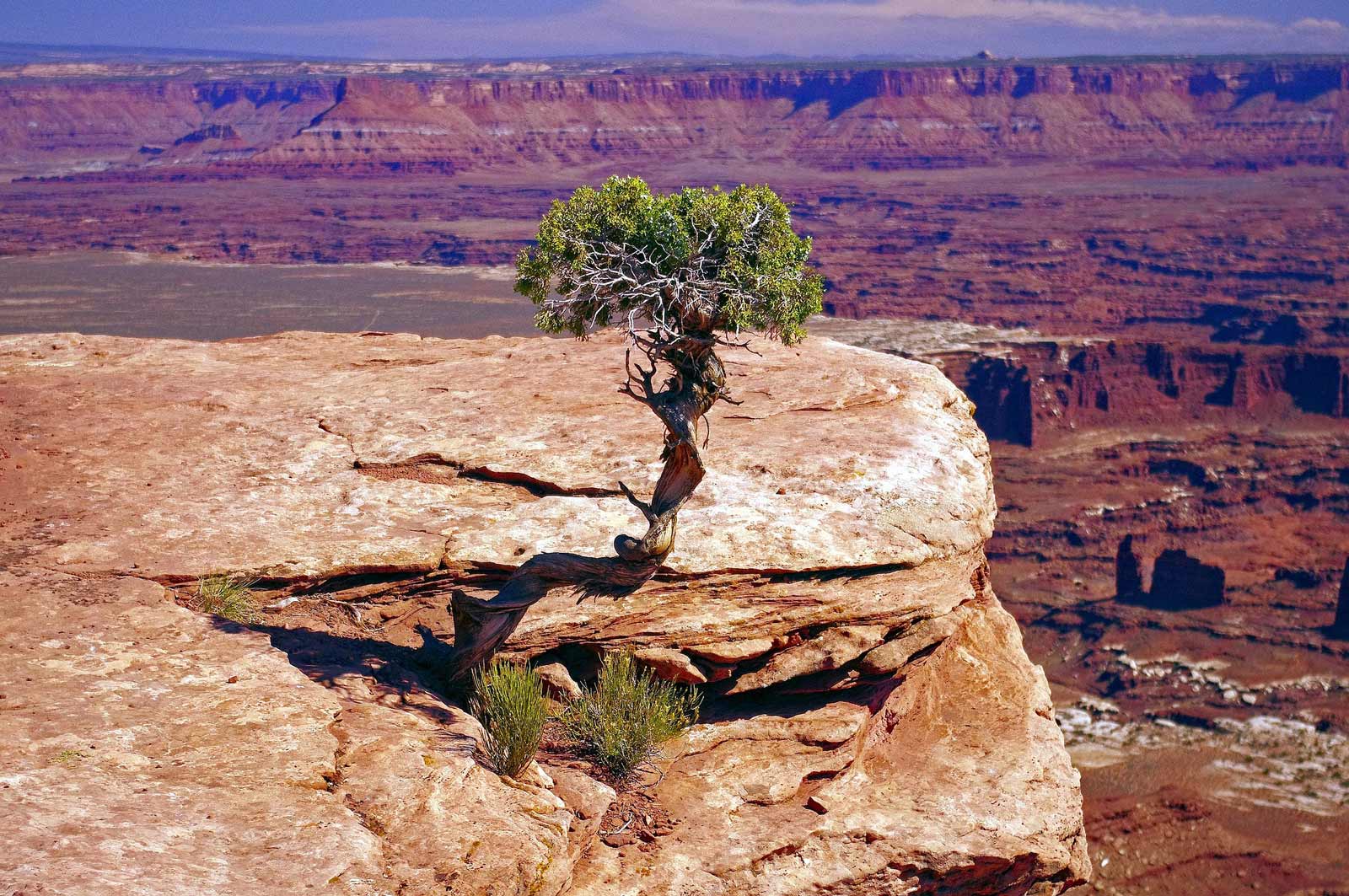
1. Druid Arch Trail
In the Needles District, the 10.8-mile moderate trail takes you off the beaten path. The entire district is great for overnight hiking and this is its crown jewel.
The primitive trail begins at the Elephant Hill Trailhead. Follow the cairns which guide you through a slot canyon before turning right towards Chesler Park. The remoteness of the trail means every blind turn offers a surprise and a magnificent view. You’ll feel like you’re exploring and not merely hiking.
2. The Mesa Arch Trail
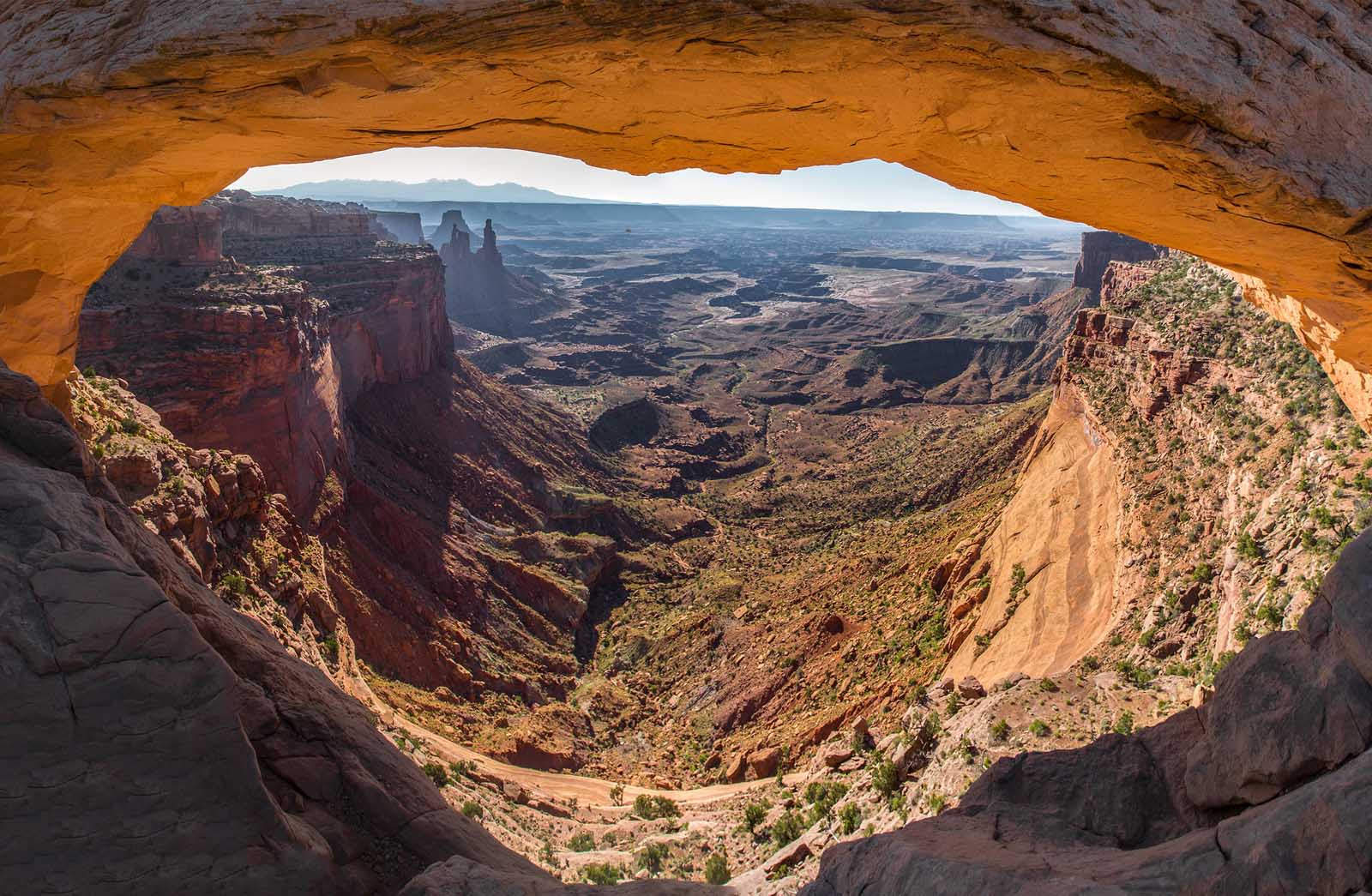
The iconic hike is only 0.5 miles long and will see some crowds compared to other longer treks. However, it’s worth braving and if you want, come at sunrise for an even more memorable hike.
Mesa Arch could be a rival to Delicate Arch for the most beautiful arch in Utah. At sunrise, the sun peeks through the gap, shining sections of the desert in light, the rest becoming a gorgeous silhouette. For an even better vista, head to the left of the arch for a short rock scramble. This will provide a complete view without the frame of the arch.
3. Murphy Point Trail
Covering 3.6 miles with little elevation, the Murphy Point Trail follows the canyon’s rim with vibrant desert views. The trail begins in a desert field leading up to the canyon. The views continue to get better until you find yourself on the precipice. Then turn and follow the rim. Along the way, you’ll look over the rolling Green River, the White Rim Road, and the impeccable Candlestick Tower. Complete the trek at sunset, with a headlamp handy for the best experience.
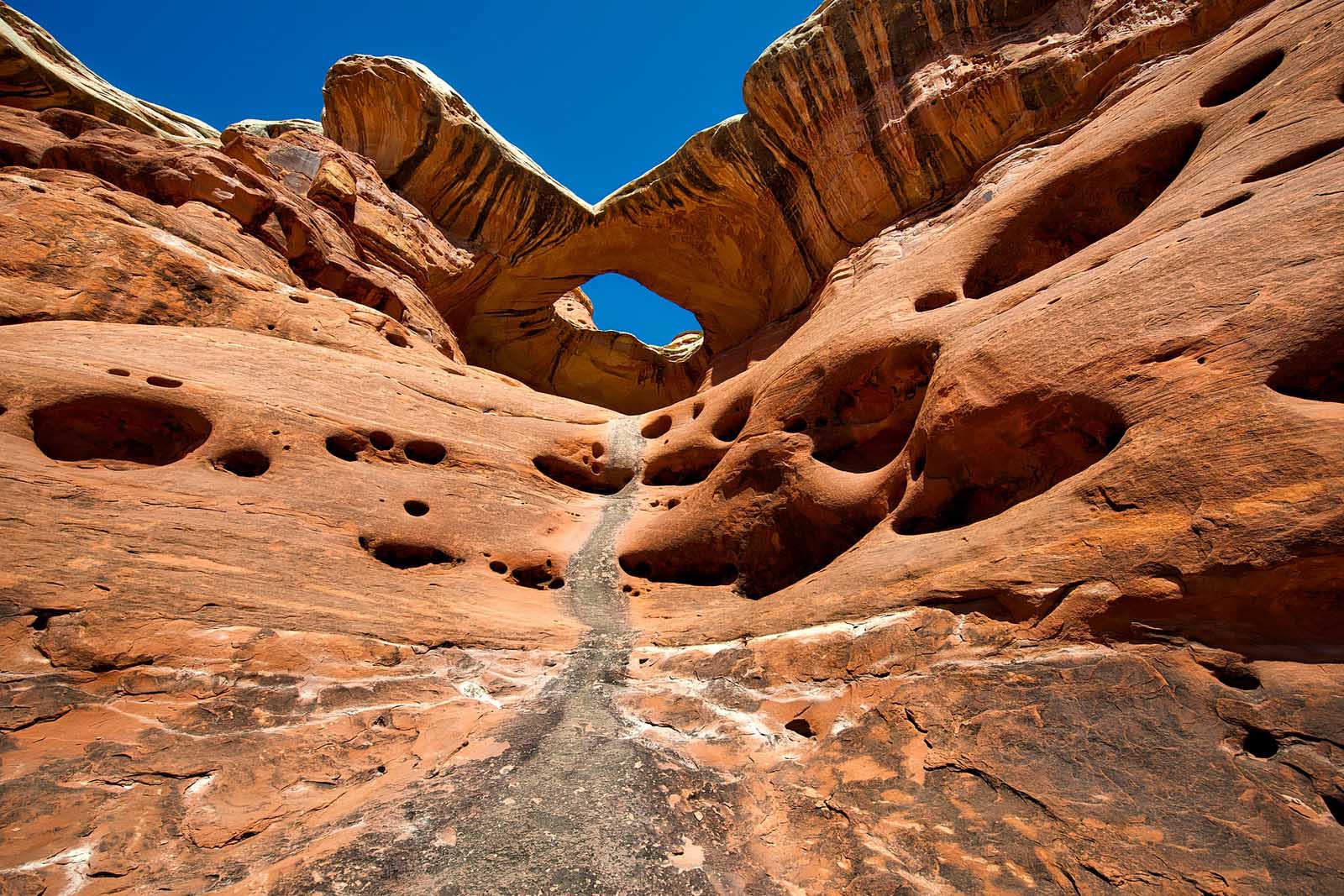
How to get there:
Canyonlands is 40 minutes from Moab, in eastern Utah. The nearest major airport is in Grand Junction.
- Moab: 38m (32.5 miles)
- Grand Junction: 2hr (124 miles)
- Salt Lake City: 3hr 55m (244 miles)
Entrance Fee:
- Private Vehicle: $30 (<15 passengers)
- Motorcycle: $25
- Walk/Ride: $15
- Southeast Utah Pass: $55
Where to stay:
Moab Springs Ranch: Nestled by the red cliffs, the Moab Springs Ranch is a blend of luxury and nature. The ranch comes with shady cottonwood trees, meadows, and springs that split the bungalows.
Red Cliffs Lodge: By the Colorado River, the Red Cliffs Lodge is a peaceful place to stay. Offering gorgeous views of the cliffs, canyons, and river, you can relax at the end of an exciting day in the Utah national park.
Helpful Tips for the Mighty 5 Utah National Parks
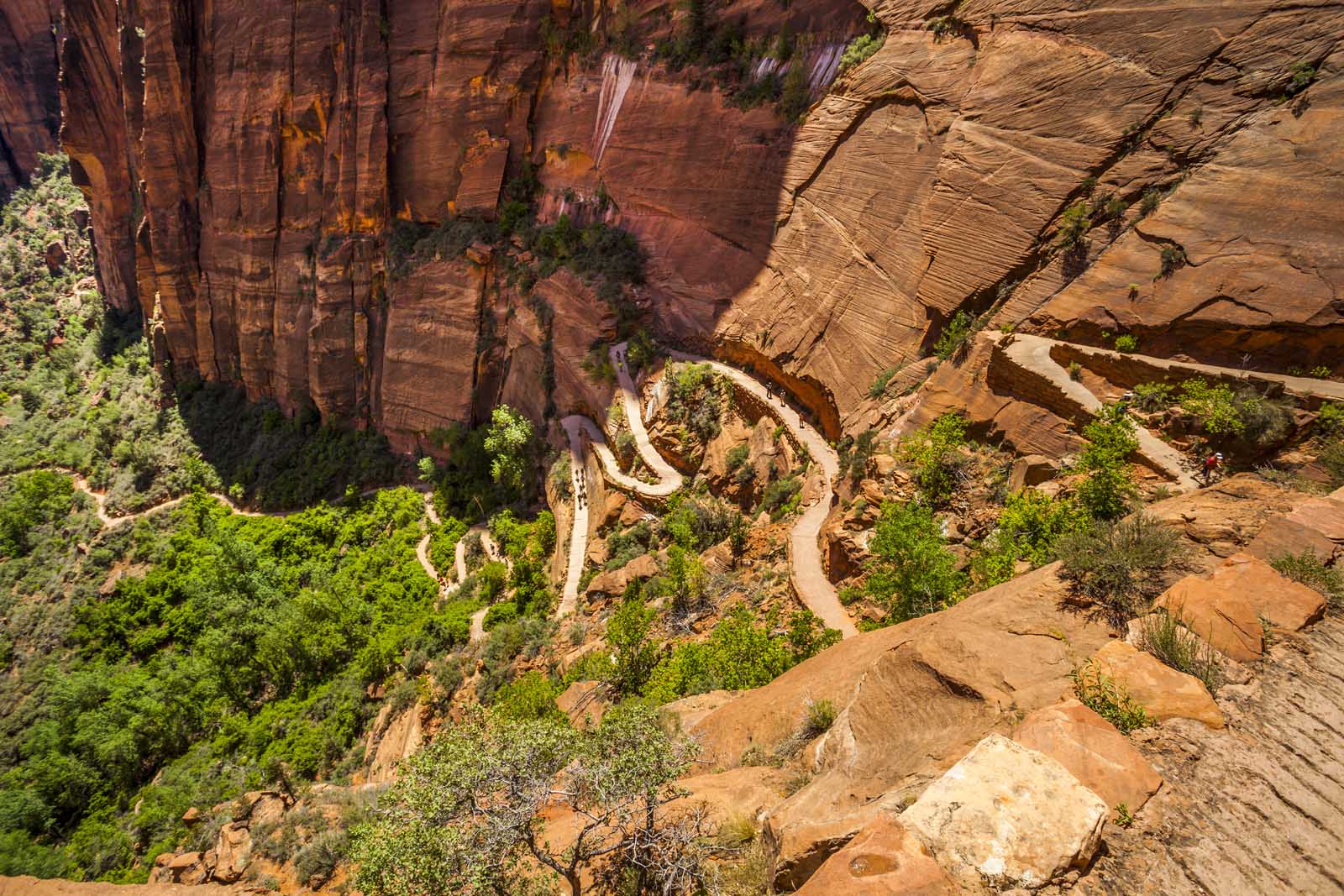
- The National Park Service offers an annual pass to all NPs for $80 a year.
- Hire a car. Avoid the tours and explore on your own time. Each park deserves at least two days.
- Combine your time at Arches with Canyonlands. The other three are all within a few hours of each other.
- Make the most of sunrise and sunset for hikes. Do the scenic drives at midday.
- Consider the winter season. The red desert covered in snow is a sight to behold.

